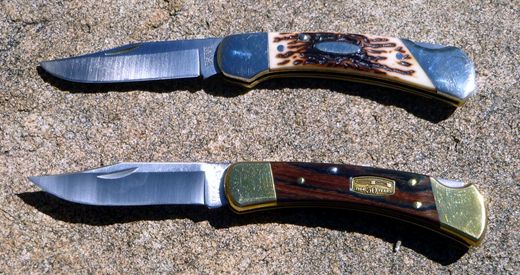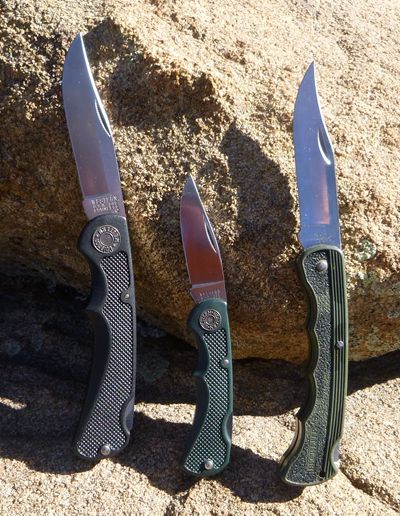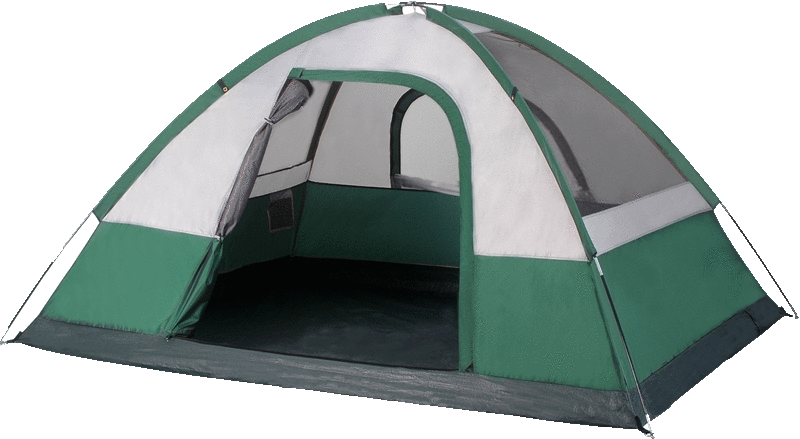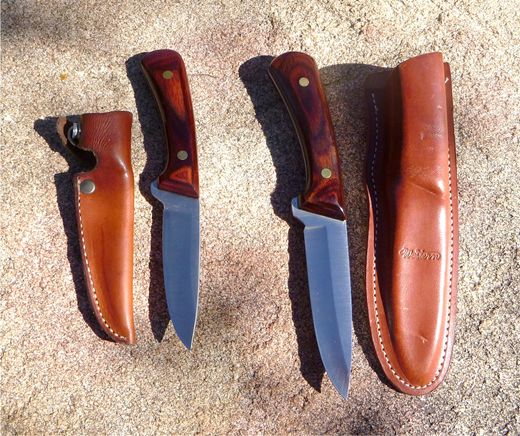This will be a Part 2 to last
month’s story on Western knives. Last time we talked exclusively about
Western fixed blade sheath knives, focusing on the classic stacked leather
handled knives that used Western’s patented split tang construction. This
article will take a look at a few of their knives that were introduced in
the 1980’s, in the waning years of Western’s life as an independent knife
company, plus during the time of their ownership by Coleman and Camillus.
This will be nowhere near an exhaustive look at their later products, just
a look at the ones that have caught my fancy.
W83 and W84 Drop Point Hunters
In the late 60’s, a custom knife maker named Bob Loveless introduced a new
style of hunting knife called the drop point hunter. A drop point knife is
characterized by a gentle curve along the spine that results in the point of
the blade ending up pretty much in the center of the long axis of the blade.
Arguably, this gives a knife better controllability. Deer hunters know how
important that can be when blindly reaching up into the chest cavity to free
organs when field dressing.
Prior to Loveless’s introduction of the drop point hunter design, clip point
and trailing point (upswept) blade styles were the most popular patterns for
hunting knives among American outdoorsmen.
Another major advantage of the drop point is that this blade design is much
less likely to accidentally pierce the organs when making the initial cut for
field dressing.
Finally, since the point is not as “pointy” or fine as the typical clip point
blade, the tip of a drop point knife is stronger, less prone to breakage.
By the mid to late 70’s, the popularity of the drop point knife design had
overtaken the traditional style hunting knife that Western Cutlery had been
producing since the 1930s. In 1981 or 1982, Western introduced the W83 and
W84 drop point hunters of their own design. These did not exactly mimic the
Loveless style but they certainly have their own charm.
These were full-tang fixed blade sheath knives with beautiful brown contoured
handle scales made of resin impregnated laminated wood. Another notable
change from Western’s classic hunting knives is that the W83 and W84 used 440A
stainless steel. Most of the classic Westerns used chrome vanadium high carbon
steel which was prone to rust, though in the later years the classic patterns
were optionally available in stainless as well.
Loveless style drop point hunters are almost always made with metal finger
guards where the handle transitions to the blade of the knife. The Western
W83 and W84 do not have metal bolsters. Instead the blade blank itself
extends a small bit past the wood handle scales to form the finger stop.
The W83 was the smaller one with an overall length of 7¾” and a blade length
of 3½”. The width of the blade is just under an inch at .89”. Blade
thickness is .10”
The W84 is larger with an overall length of 9”, blade length of 4¼”, blade
width of 1.05”, with a thickness of .125”. What’s more, the handle scales
are noticeably thicker than the scales on the W83 as well.
It’s hard for to me to choose which one I like better as a general purpose
hunting knife. Both are up to the job of field dressing a deer. For
everyday belt carry, I would prefer the smaller W83. It’s less likely to
be in the way, and its lighter weight is a positive. The slightly smaller
blade will be more nimble in tight confines. The W83’s sole negative is
due to its smaller, less hand-filling grip.
The W84’s handle, due to its longer length and thicker handle scales does
feel better in the hand. The blade length is longer but is not so long that
it would be a liability while making those blind cuts inside an animal’s chest
cavity. And yes, due to its larger bulk and weight, I would probably keep
this knife inside of my hunting pack rather than wear it on my belt.
The one negative that they both share as a hunting knife is the slick,
polished finish of the handles. Though the handles look really nice, they
can be slippery in the hand. That could be a real liability when covered
in blood when used for the purpose for which they were designed.
In 1985 or 1986, a third variation in this series was introduced, the W82.
It had the smallest blade of the three at 3⅜” long and featured an upswept,
rather than a drop point tip. It was designed primarily as a “bird & trout”
knife rather than as a big game knife
Western 541 and 542 Folding Lockback Hunters
A couple of issues ago, I talked about the iconic Buck
110 folding hunter. In that story I mentioned that due to Buck’s success
with the 110, that many competitors eventually came to market with copies or
interpretations of their own. Some hit the mark, some didn’t. In the 1980’s,
Western had both copies and interpretations. By “interpretations”, I mean
folding lockback knives that did not follow the classic form laid down by the
Buck 110.
Western called their lockbacks the Westlock series. They had a number of
models that were smaller than a full-size 110 with both clip point and drop
point blade designs. I deem these “interpretations” rather than copies
because of their clubby, squared off handle ends. They lacked the elegant,
classy style of a Buck 110.
However, the two Westlocks that are the same size as a 110, the Western models
541 and 542, are high quality copies that yield nothing to the Buck 110 in
terms of style or function.

Top: 1981 Western model 542 Westlock
Bottom: Buck model 110 50 Year Anniversary Edition
|
To date, I have not yet added a Western model 541 to my collection, but I do
have a 1981 model 542. The model 541 is the closest Buck 110 copy with wooden
handle scales. The model 542 features “staghorn” handle scales made of Delrin
(plastic).
Like the Buck 110, the blades are stainless steel. Where Buck uses 420HC,
Western used 440A. On the Westerns, the bolsters are made of nickel-silver
so the look is a little bit different than the Bucks which feature brass
bolsters.
Unlike the Buck 110 where the entire frame is milled from a single piece of
brass, the Western frames are a lamination of brass liners with separate
bolsters. So from the back of the knife what you see is the stainless steel
of the lock bar at the center, with strips of brass on either side, then the
nickel-silver bolsters or white Delrin handle scales as the outside layers.
It’s quite an attractive look.
The snap and lock of the blade is excellent. It gives you that “bank vault”
feel both opening and closing the blade.
The Westlocks were originally supplied with either a black or a brown leather
sheath. My eBay purchase did not come with a sheath. I picked up a Buck 110
nylon sheath which works perfectly to protect it.
Western “Mighty Light” Folding Lockbacks
To compete with Buck’s “Bucklite” knives, which were plastic handled versions
of the 110 and its smaller brothers, Western brought out the “Mighty Light”
series in the mid-80s. The Mighty Lights were every bit competitive in quality
to the Bucks. The only thing they lacked was Buck’s name recognition and
head-start in the market.

Left: Western model 546 Mighty Light
Center: Western model 526 Mighty Light
Right: Buck Model 426 Bucklite
|
The plastic that Western used is called Valox. The handles were available in
black and a dark green color. I own two examples, a black handled model 546
(same size as a Buck 110 or 426), and a green handled model 526 (blade length
of 2⅝”). The Mighty Lights are more comfortable in the hand than the
Bucklite. The Buck handles are basically square-edged slabs, where the Mighty
Lights have contoured scales with ergonomic bevels on the side where the blade
folds into the handle when closed, and a bit of a palm swell in the center of
the scales.
I’ve got to tell you that I really love my Western 546. The main reasons are
because of its ergonomic comfort in the hand, and because of its light weight
hanging on your belt. Yet when you pull it out to use it, you’ve got a pretty
substantial blade at 3¾” in length. Like the model 542 Westlock, the 546 also
has excellent snap and lock action. It has become a favorite of mine for
weekend carry.
The smaller model 526 is more of a pocket knife, not really a belt knife.
Again, because of its light weight, it is quite unobtrusive when dropped into
your pocket.
There was one more size in the Mighty Light series, an example of which I do
not own. It was the model 516. As you might guess, it was smaller yet than
the model 526 with a blade length of 2⅛”, a true pocket knife.
The two bigger ones, the 546 and the 526 were originally supplied with cheap
ballistic nylon sheaths. The black handled ones came a grey sheath. The green
handled Mighty Lights came with a green camouflage sheath. My larger 546 came
with its grey sheath, labeled “Coleman Western,” but no sheath came with the
526 from my eBay purchases. The only reason that I do not carry my 546 more
than I do is because I worry about destroying the original sheath. But Buck
110 nylon sheaths are readily available at reasonable prices, so I will get
another one of those so that I can carry the 546 more often without worry or
guilt.
Well these 1980s Westerns are out there, available on eBay. Some sellers ask
exorbitant prices, thinking that they are high-demand vintage classics. They
are not. Before I told you about these, had you ever heard of them?
But they are high quality, useful tools that do have that little extra bit of
cool factor simply because they are not available new on today’s market, and
not everybody knows about them or has one.
There are two ways to get one at a reasonable price: 1) Just keep watching
the listings for a knife in decent shape at a cost that you can swallow. 2)
Many high dollar listings have a “Make Offer” option. Don’t be afraid to
low-ball the guy. The worst he can do is say no. I’ve done that a number of
times and have made some good deals.

![]()





